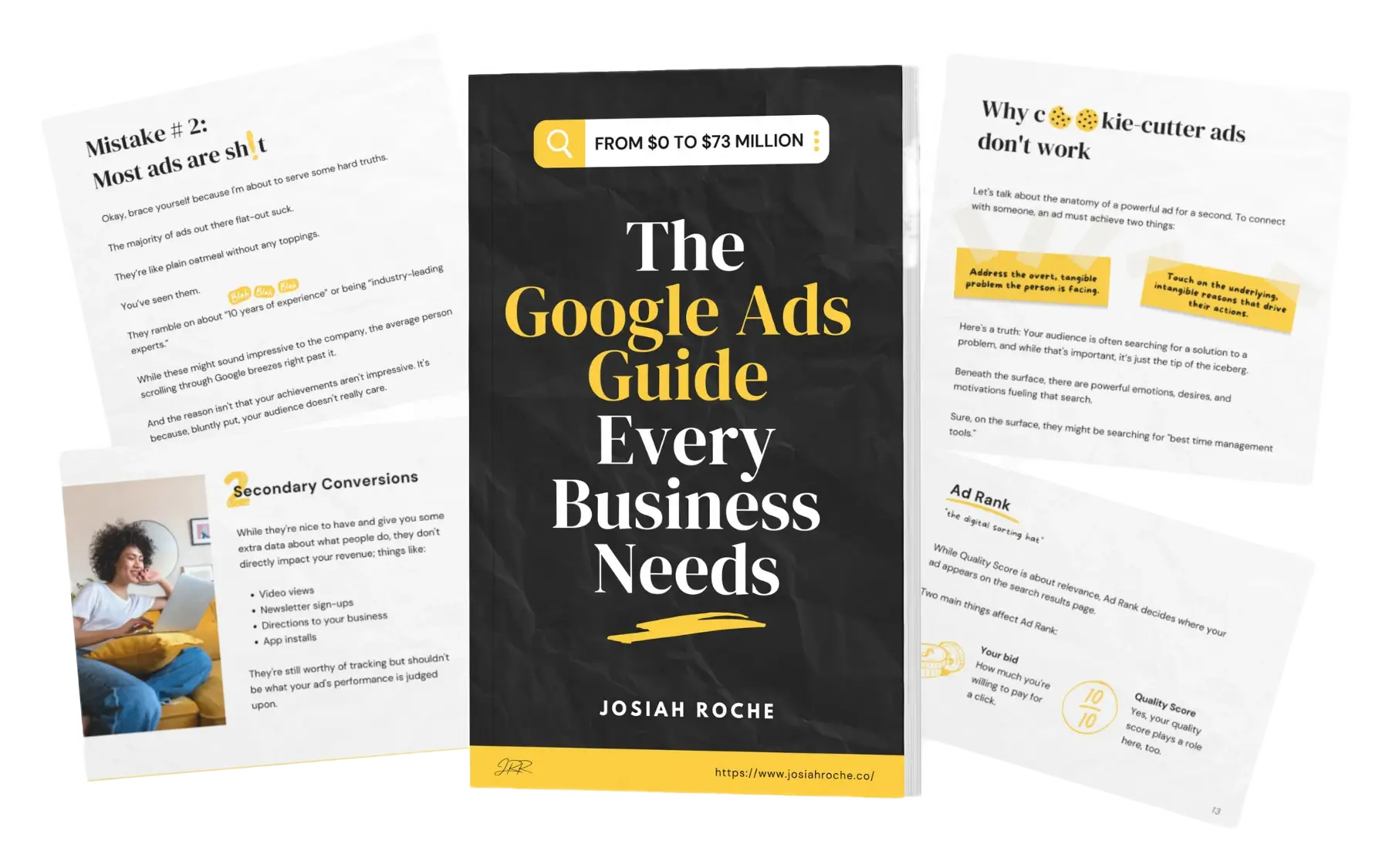You’ve got a website, and it looks good — clean design, quality content, and you’ve sprinkled in your high-ranking keywords like parsley on a pasta dish.
You might think you’re all set to climb the Google search ladder. Spoiler: you’re not.
Enter Google’s Golden Triangle, a concept that isn’t new but has evolved over time, just like your Netflix recommendations.
Back in the good old days, eye-tracking studies showed that people primarily focused on a ‘golden’ triangular area at the top left of the search results page; making it the Holy Grail for clicks
Fast-forward to today, and people’s viewing habits have changed, but the essence remains the same: top placement still matters — a lot.
What’s particularly compelling about this Golden Triangle is that it isn’t just a game of SEO.
It’s a fine blend of search engine optimisation and an understanding of sales psychology.
Being in the Triangle won’t just give you visibility; it could significantly improve your click-through rate (CTR).
And guess what? It’s not only about using the right keywords; it’s about tapping into what makes people click, both literally and metaphorically.
By the time you finish this read, you’ll see your SEO strategies and sales funnel in a new light, working cohesively like salt and pepper on a perfectly cooked steak.
Grab that cup of coffee, and let’s begin.
What is Google’s Golden Triangle in SEO?
Back in the mid-2000s, when people still debated whether Pluto was a planet, another ground-breaking discussion was happening in the digital world.
Researchers were using eye-tracking technology to work out how people interacted with search engine results pages, or SERPs as the cool kids call them.
What did they find? The Google Golden Triangle.
The study revealed that people focused their attention on a specific triangular area of the SERP, basically the top left corner.
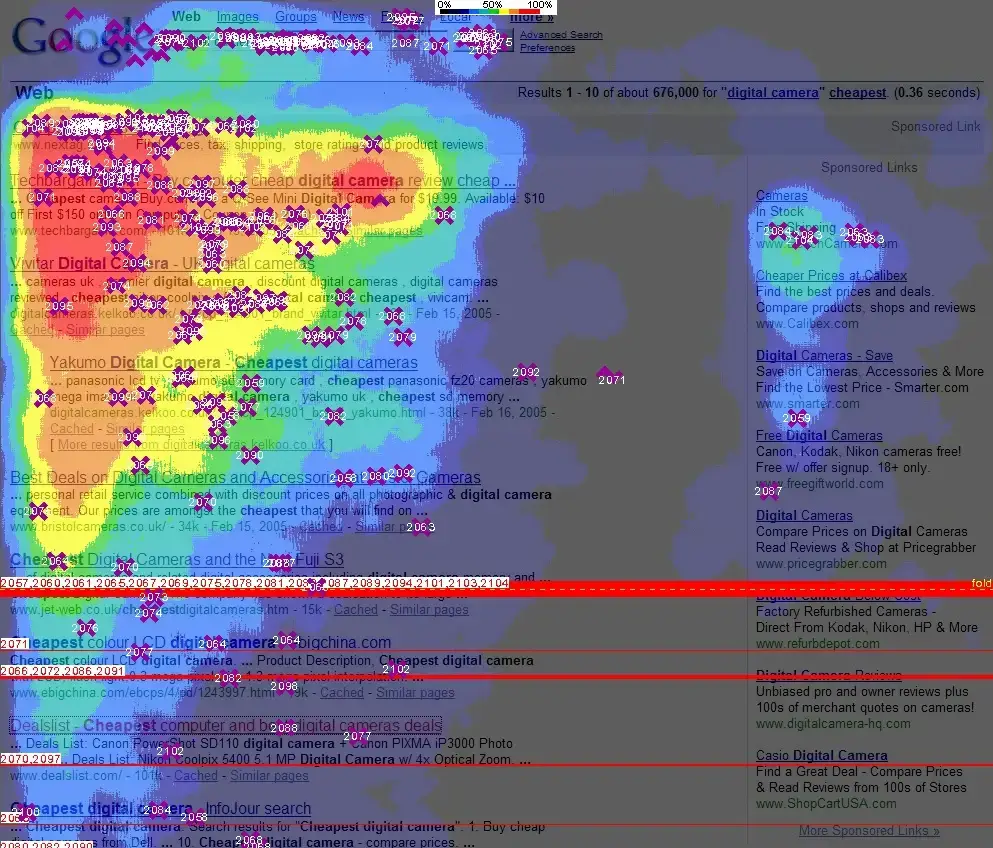
Now, within this triangle there are different zones.
- The “hot zone” is the tip of the triangle, usually where the first organic search result sits. This area is like front-row seats at a concert: everyone wants to be there.
- The “warm zone” spans the second to fifth listings, still prime real estate but not as flashy as the hot zone.
- Finally, the “cold zone” is the lower-ranking search results, the area where, let’s be honest, your eyes rarely wander unless you’re on a digital scavenger hunt.
Why is this important? According to Mediative’s eye-tracking study, back in 2005, people spent nearly 2 seconds viewing each listing.
Today, that’s shrunk to a skimpy 1.17 seconds. Yet, the power of the Golden Triangle remains.
The top organic listing still captures a significant portion of click activity (32.8%), demonstrating its continuing relevance.
Has the Golden Triangle evolved?
Just as we moved from flip phones to smartphones, Google’s Golden Triangle has seen its share of change.
Mobile devices have played a massive role in reshaping this.
Gone are the days of desktop supremacy; people are now glued to their smartphones, and that has brought a shift in how they interact with SERPs.
Mobile screens have limited real estate compared to their desktop, nudging people to scroll more vertically than horizontally.
This behaviour has, in effect, stretched the Golden Triangle into something more like a “Golden Rectangle,” with eyes scanning down the list of results more than before.

In this mobile-first world, searchers are now conditioned to look vertically for the fastest path to the content they desire.
But mobiles are just one side of the coin.
Search engine algorithms have evolved too, introducing features like:
“People Also Ask” boxes, featured snippets, and local listings that sprinkle distractions and diversions throughout the SERP.
This also impacts how the Golden Triangle works today.
Interestingly, according to the latest studies, lower-ranking businesses (especially those in positions 2-4) are seeing more click activity than in yesteryears.
It seems people are willing to drift their eyes a bit more, giving underdogs a fighting chance to claim a piece of the action.
So yes, the Golden Triangle has evolved, and it continues to do so.
The savvy digital marketer will adapt, understanding that while the geography has changed, the quest for those coveted clicks remains the same.
The essentials of climbing to the top
If you’re going to scale Mount Everest, you’d better have the right gear, the right team, and, most importantly, the right strategy.
Similarly, aiming for the top of Google’s results — be it the classic Golden Triangle or its modern, mobile-friendly version — requires careful planning and execution.
There are two main ways to get there: Organic SEO and Google Ads.
Let’s unpack these one by one.
The (kinda) free option — Organic SEO
Organic SEO is like a home-cooked meal: it takes time, but the results are often more satisfying and long-lasting.
It all starts with keyword research.
Think of keywords as the spices in your dish. You can’t just throw in any random spices and expect it to taste good; it requires a calculated mix.
The right keywords need to be sprinkled throughout your content, meta descriptions, and titles.
Tools like SE Ranking can offer invaluable insights into what your target audience is actually searching for.
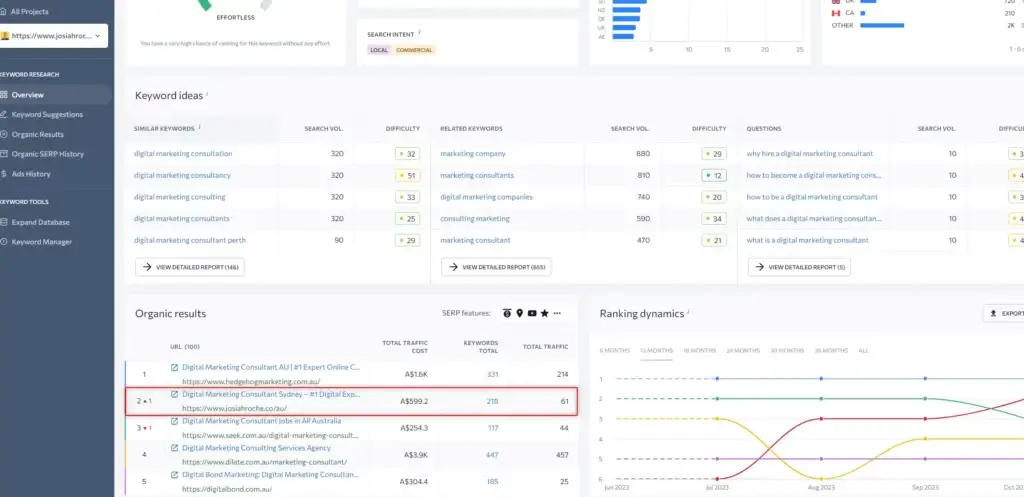
However, keywords aren’t the be-all and end-all.
Quality content is your main course. It needs to be valuable, shareable, and most importantly, relevant to the user’s query.
With Google’s new “Helpful Content Update,” the search giant is cracking down on low-quality, spammy content.
Regular updates from Google are affecting millions of sites with less-than-stellar content.
The aim? To ensure that what lands in the coveted top spots of the search engine is not just well-optimised for keywords, but also genuinely helpful, informative, and high-quality.
A keyword-stuffed article that offers no real value is like a cake made entirely of frosting; it’s just too much.
Instead, aim for well-researched, thorough content that addresses your audience’s questions and needs.
This combination of keyword strategy and quality content is your best bet for climbing up those search result rankings organically.
The paid option — Google Ads
If Organic SEO is the home-cooked meal, then Google Ads are the fast food of the digital world — quick, to the point, and it’ll cost you.
Google Ads can guarantee your place at the top of the SERP, but as the saying goes, there’s no such thing as a free lunch.
You’ll need to participate in keyword bidding, where you essentially auction for the top spots against competitors targeting the same keywords.
This bidding isn’t just about who has the deepest pockets.
Google also considers the relevance and quality of your ad and landing page.
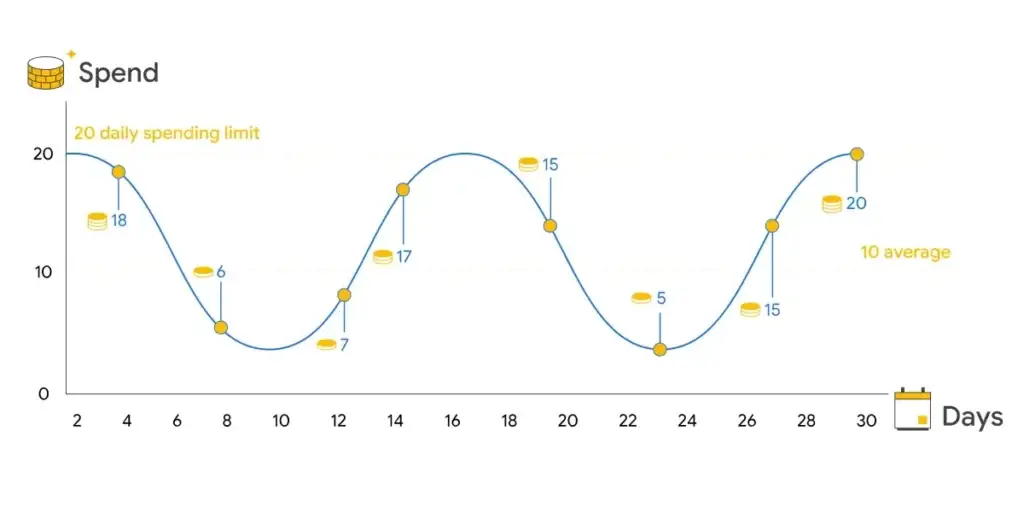
So even if you’re willing to shell out top dollar, a poorly designed ad that doesn’t resonate with searchers can still lose out to a more relevant one.
It’s like a talent show where both skill and crowd appeal matter.
So while Google Ads can offer a fast-track to top placement, it comes at a price, both literally and metaphorically.
You’ll need to strategise carefully, ensuring that the keywords you bid on are not just high-traffic, but also highly relevant to your business and content.
Why your meta matters — titles and descriptions
Consider your meta titles and descriptions as the movie trailer to your content.
They give the audience — or in this case, the searcher — a glimpse of what’s in store, enticing them to click and learn more.
It’s not just about ranking; it’s also about standing out in the crowd once you’re up there.
The meta section is where SEO meets sales psychology, and believe me, getting this intersection right can significantly impact your click-through rate (CTR).
For example, which of these two meta titles is more compelling?
- “10 Tips for Better Gardening”
- “10 Proven Tips to Transform Your Garden in 30 Days”
The second one not only includes a number (which our brains love) but also adds an element of transformation and a time frame.
It speaks to our inherent desire for rapid, visible change and improvement.
Similarly, for meta descriptions:
- “Our blog post covers gardening tips.”
- “Unlock the secret to a lush, vibrant garden. Our 10 expert tips will show you how to see remarkable results in just one month.”
Again, the second description taps into our curiosity, our aspiration for improvement, and provides the promise of speedy results — all strong elements of sales psychology.
To bake in numerical data, a description like “Join 5,000+ happy gardeners who have transformed their gardens using our proven tips” adds social proof, a powerful motivator for clicks.
So, think of your meta title and description as your 30-second (more like 1-second) pitch.
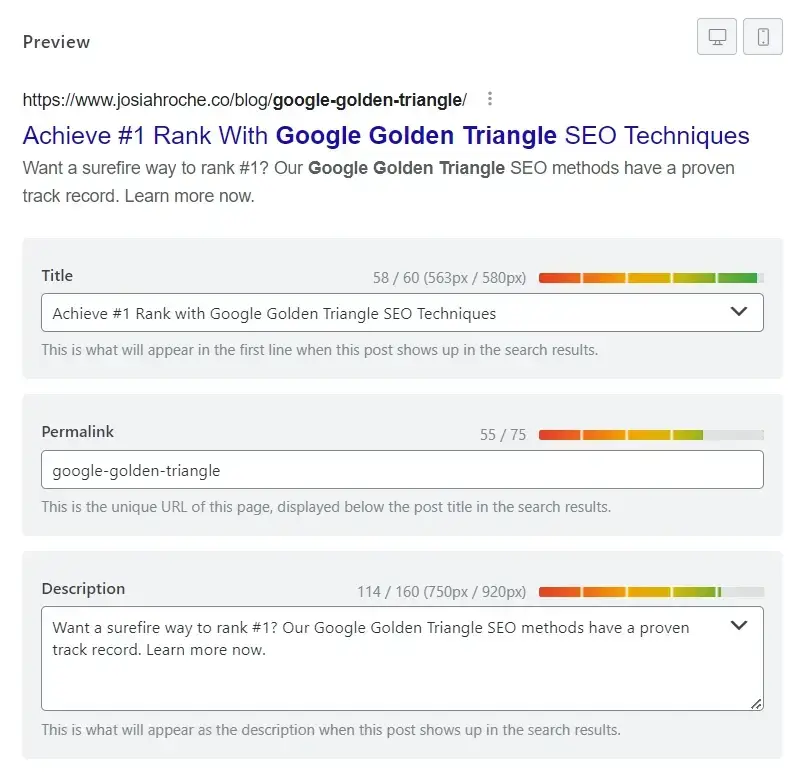
You have limited space to not just say what the page is about, but also to convince the searcher that clicking on your link will solve their problem or answer their question.
Just remember, an eye-catching meta title and description won’t mask bad content.
It may get people through the door, but the main course — your content — is what will make them stay.
The Impact of Numbers (it’s not just a stat game)
You’ve probably noticed that numbers often pop up in headlines, meta titles, and descriptions.
No, that’s not by chance.
There’s psychology at play, and it goes a bit deeper than our third-grade maths class.
Numbers capture attention because they represent certainty, something tangible among a sea of words.
They promise a certain return on investment for the time you’ll spend reading.
After all, who wouldn’t prefer “3 Easy Steps” over “Some Easy Steps,” or be intrigued by “Increase Your Sales by 50%” instead of “Increase Your Sales Significantly”?
Numbers offer bite-sized, easily-digestible information that gives us a sense of what to expect.
A title like “5 Ways to Improve Your CTR” offers both a scope and a promise.
The reader knows they’ll walk away with five specific strategies, making the click a lower-risk proposition.
But the impact of numbers isn’t confined to just your titles and meta descriptions.
Sprinkling data points, percentages, or numerical evidence throughout your content reinforces your points and adds credibility.
Essentially, numbers are to convey what a strong base note is to a complex fragrance — it’s the thing that pulls everything together and leaves a lasting impression.
The Golden Triangle and you: practical steps
So you’ve learned about the importance of the Golden Triangle, the role of metadata, and the psychology of numbers.
But knowledge without action is like a sports car without fuel — good to look at but going nowhere fast.
Let’s talk about some practical steps you can take to boost your site’s performance in the Golden Triangle.
Step-by-step SEO audit
Start by performing a basic SEO audit.
Use tools like SE Ranking, Screaming Frog, Google Analytics, and Google Search Console to understand where you’re at.
- Are your keywords ranking?
- How is your site speed?
- Is your content up to date and relevant?
Make a list of areas that need improvement, and don’t forget to pay attention to both on-page and off-page SEO.
This audit will help you see the gaps that are keeping you from reaching that coveted triangle.
Budgeting for Google Ads
As for Google Ads, it’s a pay-to-play platform but doesn’t have to be a bank drainer.
Start small and scale up.
Use Google’s Keyword Planner to find out the average cost per click (CPC) for your targeted keywords.
Set a daily or monthly budget based on your findings and closely monitor the performance.
You can always adjust your budget based on the ROI you are seeing.
Remember, it’s not about who spends the most; it’s about who spends the smartest.
Crafting captivating metadata
When it comes to writing meta titles and descriptions, think of yourself as a mini-advertiser for your page.
Employ the ‘Four U’s of copywriting’: make it
- Useful
- Urgent
- Unique
- and Ultra-specific
Use numbers, invoke curiosity, and address the reader’s problem or question.
Make sure your meta is aligned with the content it describes. It’s your 30-second pitch, so make it count.
By implementing these practical steps, you’re not just throwing spaghetti at the wall and hoping it sticks.
You’re applying a strategic layer of marinara, meatballs, and maybe even some Parmesan, turning your SEO game into a full Italian feast.
What’s your next move?
The ball is now firmly in your court.
We’ve finally discussed Google’s Golden Triangle, dived into the nuances of SEO, and even sprinkled in a bit of sales psychology.
But all of these tools are only as good as the hands that wield them.
Don’t just sit on this information; implement it.
Start with a straightforward SEO audit, consider allocating a sensible budget for Google Ads, and don’t underestimate the power of compelling metadata.
The landscape of search engine ranking is ever-evolving, and adaptability is key. So go ahead, make your next move.
Experiment, tweak, and keep an eye on those metrics. The path to a higher click-through rate isn’t a straight line; it’s a journey full of insights, adjustments, and of course, clicks.

